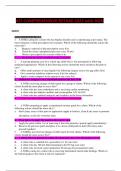Exam (elaborations)
ATI COMPREHENSIVE RETAKE 2023 with NGN RECENT
- Course
- Institution
ATI COMPREHENSIVE RETAKE 2023 with NGN RECENT ATI COMPREHENSIVE C 1. A NURis caring for a client who has bipolar disorder and is experiencing acute mania. The nurse obtained a verbal prescription for restraints. Which of the following should the actions the nurse take? A. Request a renewal ...
[Show more]



